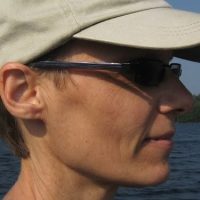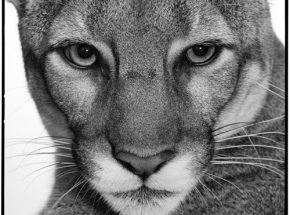

Dozier Bell was born in Lewiston, Maine, in 1957. She studied painting at Smith College in Northampton, MA, and as a graduate student with Neil Welliver at the University of Pennsylvania in Philadelphia. She attended the Skowhegan School of Painting and Sculpture on a full scholarship in 1985. Original influences were the stillness and subdued palette of northern European painters of the Renaissance and Reformation eras, such as Memling, Campin, Holbein, Van der Weyden and Van Eyck.
In 1987, a New York City gallery began representing her imaginary landscapes, inhabited only by dogs, and she won a National Endowment for the Arts Fellowship in painting. A variety of work in gouache collage, photography, and oils was tied together by the concept of a historical sense of place that precedes one’s own lifetime, an idea that Bell termed “genetic memory,” which she believed was akin to the consciousness of animals. This work was featured in a 1994 show at the Farnsworth Art Museum in Rockland, Maine, with sculptor Ken Greenleaf.
In 1991, Bell began work on a series of photomontages intended to explore more specifically the development of her own sense of place. A series of 12 photomontages, matrices of 8 or 9 photographs mounted edge-to-edge, juxtaposed images of a farm in western Maine on which her family has lived for several generations with other images familiar from childhood. These were shown as a group in 1995 at the Portland Museum of Art in conjunction with a long poem by the Maine poet Wesley McNair, whom Bell met at the Rockefeller Foundation Study Center in Bellagio, Italy in the spring of 1993.
In 1995, a life-long interest in Germany and the World Wars led Bell to a Fulbright Fellowship at the Bauhaus University in Weimar, Germany, where she worked as an artist in residence. Out of this period came the “Conflict Series,” a group of 82 small paintings done over the course of several years, exploring the environment of war.
Readings on the technologies developed during the wars led to an interest in remote sensing technologies such as radar, sonar and LANDSAT. Bell makes use of the metaphorical dimensions of these technologies in her otherwise Romantic-influenced landscapes, which are frequently punctuated by Réseau crosses, sighting devices, and other geometric forms. In 1997, the Maine College of Art presented Bell with an honorary Doctor of Fine Arts degree. Much of the war-inspired work was featured in solo shows at the Lyman Allyn Museum of Art in New London, Connecticut in 1998, the Hudson River Museum in Yonkers, New York in 2003, and the National Academy of Sciences in Washington, DC in 2004.
Some of the most recent work explores the theme of global warming and its possible consequences by harking back to echoes of environmental catastrophes from the past, such as the period of the Black Death. Bell’s work as a whole can be seen as a continuation of the Northern Romantic tradition, with its emphasis on the terror as well as the sublime beauty of nature.
www.aucocisco.com/artists/dozier_bell/bio.html
Website
http://dozierbell.com
